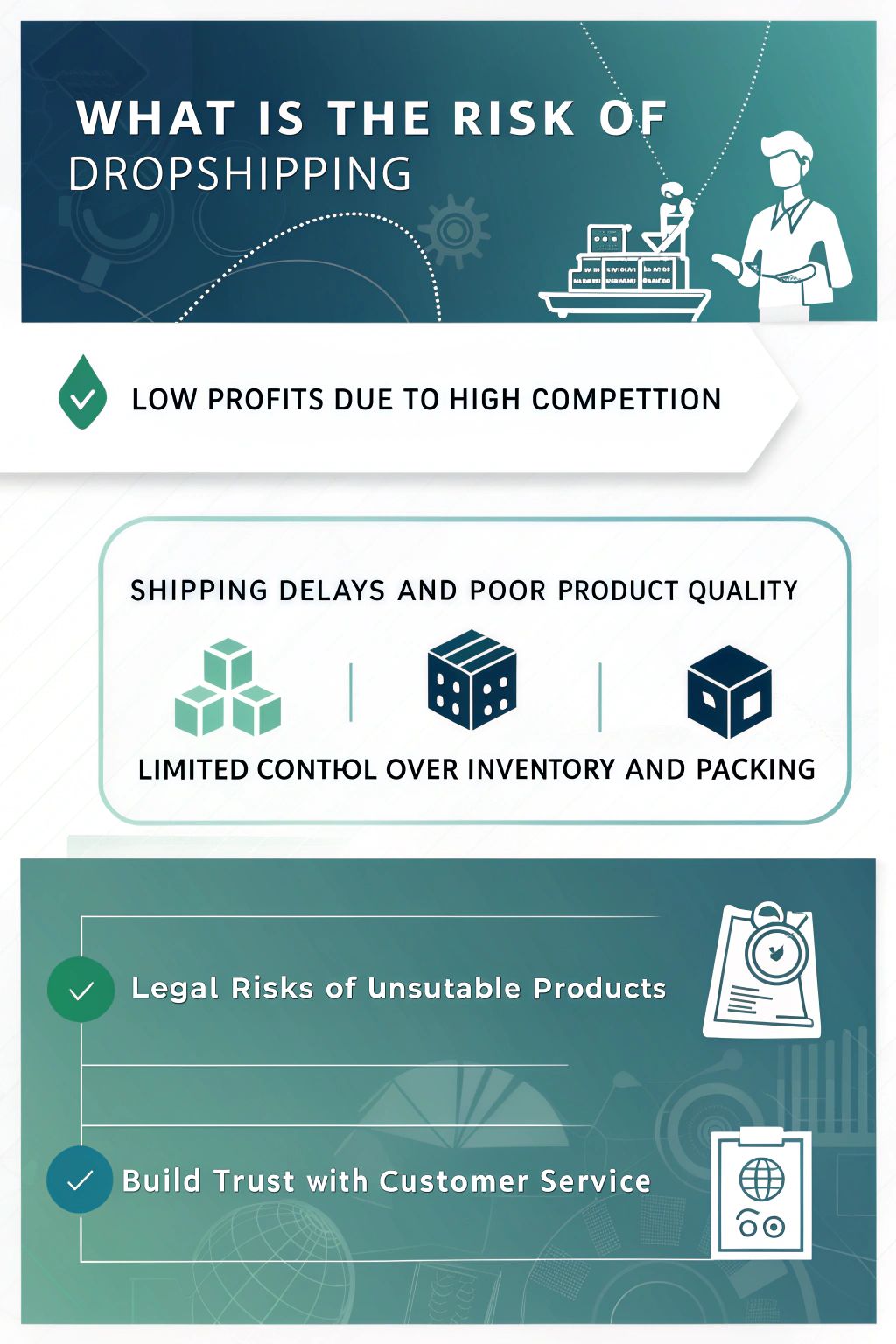Starting a dropshipping business sounds easy, right? No need for upfront stock or a physical store. But many beginners quickly find themselves overwhelmed by hidden risks. Low profits, supplier issues, and customer complaints can turn that dream into stress.
For example, imagine relying on suppliers who ship late or send the wrong items. This can ruin your reputation fast! These are just a few challenges dropshippers face daily.
This blog will explain common risks like these and how to handle them. Keep reading to protect your business from costly mistakes!
Key Takeaways
- Dropshipping has low profits because of high competition and extra costs like supplier fees.
- Suppliers can cause issues with shipping delays, wrong items, or poor product quality.
- Dropshippers have little control over inventory, packaging, and product availability.
- Legal risks come from selling unsafe products or not following rules.
- Good customer service and trusted suppliers help reduce complaints and build trust.

Low Profit Margins

Dropshipping businesses often face narrow profit margins. High competition pushes prices down, making it hard to earn more per sale. Retailers must balance pricing pressures while covering fulfillment and shipping costs, which can quickly eat into profits.
Automated systems may save time but won’t guarantee higher earnings.
Offering fast shipping or quality products often means paying higher upfront costs. Flexible wholesale purchasing helps avoid overstocking but doesn’t promise better profitability.
Platforms like Shopify simplify operations, yet they cannot solve the issue of eroding profit margins caused by competitive pricing strategies in this crowded market.
High Competition in the Market
Many dropshippers face fierce market competition. Thousands of sellers offer similar products, making it hard to stand out. A diverse range of over 20,000 smoke shop products from SmokeDrop helps fight this issue.
Identifying niche products using advanced search tools can reduce risks and attract buyers.
Efficient order fulfillment and inventory management are key to staying competitive. Automated systems save time and lower errors. Platforms like Shopify or WooCommerce allow seamless integration for streamlined operations.
Flexible wholesale pricing also gives an edge, letting sellers adapt quickly to price changes in the market.
Limited Control Over the Supply Chain
You can’t control your supplier’s stock or shipping speed, and this can cause big headaches… keep reading to learn how to manage these issues better!
Inventory management challenges
Dropshipping relies heavily on suppliers for stock, which can create problems. If a supplier runs out of products, the store owner can’t fulfill orders. Inaccurate inventory tracking makes it hard to know what’s in stock—this leads to delays or canceled sales.
Automation tools help sync inventory between parties but do not solve all issues. Issues worsen with large-scale operations as wholesale pricing grows yet supply chain control stays weak.
Integration with online platforms like Shopify might ease management but doesn’t fully prevent errors in fulfillment or stock updates.
Shipping delays and errors
Shipping errors can upset customers. Late packages and wrong orders cause frustration. Dropshippers depend on suppliers for shipping, which limits control. This often leads to delays or mistakes in order fulfillment.
Using tools like SmokeDrop helps reduce these problems. It automates the process, making it reliable and fast. Order syncing improves accuracy and keeps everything transparent. Retailers must also monitor inventory closely to avoid out-of-stock issues during busy times.
Quality Assurance Issues
Product quality can be all over the place with dropshipping—sometimes great, other times a total mess. Keep reading to find out why this happens!
Inconsistent product quality
Dropshipping often depends on third-party suppliers. This can lead to inconsistent product quality. Retailers have limited control over the items they sell. Suppliers may not follow strict quality standards, causing issues for customers.
Discrepancies happen if suppliers miss important checks or skip proper oversight.
The push for lower costs adds to these problems. Trying to get better margins might force retailers to pick cheaper suppliers who lack high-quality products. Automatic order syncing can also cause errors if a supplier fails to maintain quality assurance processes.
These challenges hurt trust and repeat sales, especially when items do not meet expectations.
Lack of control over packaging
Suppliers manage the packaging in dropshipping. This can lead to poor packaging quality or defects. Damaged boxes, unclear product labeling, and unsafe materials may frustrate buyers.
Such issues hurt a brand’s image and trust.
Dropshippers cannot check each package before shipping. They rely on suppliers to follow proper packaging standards and compliance rules. If there are errors, they risk receiving complaints or returns from customers.
Difficulty in Building a Brand
Standing out is tough when everyone sells the same stuff—keep reading to find out why.
Lack of product uniqueness
Many dropshipping platforms, like SmokeDrop, offer catalogs with over 20,000 products. This huge variety may seem great but can create problems. Retailers often sell the same items, leading to market saturation and tougher competition.
The easy import process makes it simple for many sellers to offer similar goods. Automated inventory tools also reduce differences between retailers’ offerings. Flexible pricing and no minimum orders add more competitors selling alike products.
This lack of product differentiation hurts brand distinctiveness in a crowded space.
Dependence on suppliers
Dropshippers rely heavily on suppliers for inventory and order fulfillment. This creates supply chain vulnerabilities. Stock may run out, leaving customers unhappy. Shipping delays or damaged goods can harm customer satisfaction and brand reputation.
Unpredictable supplier pricing adds more challenges. Profit margins might shrink, making it hard to stay competitive. Dropshippers also struggle with controlling shipping times and product conditions.
These issues often lead to negative reviews or lost trust from buyers.
Legal and Compliance Risks
Selling unsafe products or ignoring rules can lead to legal trouble—learn how to avoid these risks.
Liability for unsafe products
Dropshippers face risks if products harm users. Smoke items like vapes and CBD products often have strict safety laws. Breaking these can lead to legal liabilities, fines, or business bans.
Retailers must ensure all items meet product safety regulations before sale.
Automated dropshipping tools help with tasks but do not erase liability risks. Product injuries or defects still link back to the seller—not just the supplier. Always double-check quality and choose reliable sources to avoid costly lawsuits or unhappy customers.
Non-compliance with product regulations
Selling products that fail to meet regulations can cause big trouble. Every country has strict rules for product safety and legal requirements. Failing to follow these can lead to compliance violations, fines, or even lawsuits.
For example, selling an unsafe toy could result in penalties or being banned from certain markets.
Dropshippers risk legal consequences if suppliers don’t follow regulatory standards. Many suppliers may skip proper testing for their items. This puts sellers at risk of noncompliance penalties and damages their reputation with buyers.
Risk management is key—working only with trusted suppliers helps reduce these problems.
Customer Service Challenges
Helping unhappy customers can be hard, especially if they get damaged or incorrect items. Keep reading to learn how to handle these problems smoothly!
Handling returns and refunds
Handling returns and refunds can be tricky in dropshipping. It impacts customer satisfaction and the overall shopping experience.
- Returns often take longer since products are shipped back to suppliers, not directly to sellers. This delay frustrates buyers.
- Refund requests may increase if product quality does not meet expectations. Poor-quality goods lead to unhappy customers.
- Return policies depend on supplier rules, making it harder for sellers to remain flexible or fair with buyers.
- Return shipping costs add up quickly, especially if suppliers do not cover them for defective items.
- Exchanges are rare since the process can be slow and inconvenient due to indirect shipping paths.
- Resolving customer complaints becomes harder without any direct control over shipping or packaging errors.
- Tracking refund status may confuse buyers since sellers don’t fully oversee the process themselves.
Managing customer complaints
Customer complaints can hurt your business if not handled properly. Dropshipping has unique challenges that make managing these complaints tricky.
- Automated order fulfillment helps reduce errors. Fixing mistakes quickly keeps customers happy and saves time.
- Platform integration with Shopify or WooCommerce prevents order problems. Clear communication between systems ensures smooth processes.
- Real-time inventory syncing avoids selling out-of-stock items. Customers trust stores with accurate updates.
- Transparency in order tracking reassures buyers about delays or issues. Sharing honest updates builds trust and reduces frustration.
- A wide product catalog minimizes complaints about limited choices. Offering variety keeps shoppers satisfied.
- Quick shipping options solve delivery issues faster. Faster solutions leave a better impression on customers.
- A user-friendly interface simplifies returns and refunds for buyers and sellers alike. Easy systems prevent unnecessary stress for everyone involved.
Financial Risks
Financial risks can sneak up fast—with surprise supplier fees or shaky profit margins that leave little room for error. Keep reading to learn how to avoid them!
Hidden supplier fees
Hidden supplier fees can hurt profit margins fast. Suppliers may charge unexpected costs, like integration fees for Shopify or WooCommerce. These charges add up and make it hard to keep track of real profits.
Some suppliers also add hidden expenses during wholesale purchasing, even with no minimum order amount. Retailers must stay alert to unanticipated charges that could harm financial viability.
Careful planning is key to avoid these risks while maintaining healthy profits.
Unpredictable profit margins
Extra supplier fees can already strain finances. On top of that, fluctuating profit margins make dropshipping tricky. Market volatility and price competition on platforms like Shopify or WooCommerce keep profits unstable.
Wholesale pricing may seem flexible, but it adds to the unpredictability.
Inventory control and automation errors also impact earnings. Order fulfillment delays or mistakes cut into profits fast. Managing multiple products across brands only increases risks, creating more financial uncertainty for sellers in this business model.
Can You Lose Money Dropshipping Using [Service]?
Yes, dropshippers can lose money if they’re not careful. Hidden supplier fees might eat into profits. Unpredictable profit margins due to high competition can also cause problems.
Shipping delays and slow tracking systems hurt customer trust, leading to lost sales. Even with platform integration like Shopify or WooCommerce, poor planning affects business scaling and shipping reliability.
Steps to Mitigate Dropshipping Risks
Taking precautions can save your business from big problems. Simple actions like picking good suppliers and checking products often make a huge difference.
Conduct thorough market research
Study market trends to find what products are in demand. Check customer demographics to know who will buy your items.
Analyze competitors to see their strengths and weaknesses. Research the supply chain for issues that might cause delays. Use economic trend analysis to predict future challenges or opportunities.
This leads directly into choosing reliable suppliers next.
Partner with reliable suppliers
Finding the right suppliers is key to reducing dropshipping risks. Reliable suppliers, like SmokeDrop, offer tools to make operations smooth and efficient. They provide an extensive catalog of over 20,000 smoke products and accessories.
This gives businesses plenty of choices without needing a large upfront investment.
SmokeDrop integrates with platforms like Shopify, WooCommerce, and BigCommerce. It also offers automated order fulfillment, inventory synchronization, and tracking updates. These features save time and ensure accurate delivery.
Plus, there are no minimum order requirements—making it easier for small retailers to grow at their own pace!
Regularly test and inspect products
A reliable supplier is helpful, but testing the products yourself is key. Dropshippers should consistently check and assess items for quality. This step ensures customers get what they expect.
Faulty or low-quality goods can lead to refunds, returns, and bad reviews.
Routinely inspect merchandise before adding it to listings. Order samples of new products to examine them closely. Look at durability, functionality, and overall performance. Regularly verify packaging as well—damaged goods in transit hurt your reputation fast!
Optimize customer service processes
Automated order fulfillment speeds up processes and keeps customers happy. Syncing orders automatically improves how well orders are managed. These steps save time and cut down on mistakes, keeping things running smoothly.
Integration with e-commerce platforms simplifies operations. A transparent tracking system helps customers stay informed about their orders, building trust. Flexible dropshipping options mean faster responses to customer needs, boosting satisfaction.
Conclusion
Dropshipping comes with risks, but careful planning can help. Low profits, shipping issues, and customer complaints are common problems. Choosing trusted suppliers and testing products can reduce these risks.
Simple steps like better service and clear policies also improve success. Start small, stay smart, and grow steadily in your business!
FAQs
1. What are the main risks of dropshipping?
Dropshipping can lead to problems like unreliable suppliers, late shipping, and poor product quality. You also have little control over inventory or customer service.
2. Can dropshipping hurt my business reputation?
Yes, it can. If a supplier sends damaged products or ships orders late, customers will blame your business—not them.
3. Is it hard to make money with dropshipping?
It can be tough because profit margins are often small. Plus, competition is high since many businesses sell the same products.
4. Are there legal risks in dropshipping?
Yes! Selling items without checking for trademarks or copyrights could get you into trouble (and trust me—you don’t want those headaches). Always research what you’re selling first!



